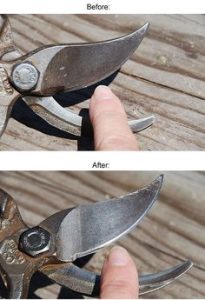To counteract the vinegar’s acidity, immerse the pruners in a jar filled with water and around 2 tablespoons of baking soda. Leave them in the solution for about 10 minutes.
7. Drying:
Remove the pruners from the baking soda solution and let them air dry completely before proceeding.
8. Sharpening:
If your pruners are not severely rusted, you can clean them with soapy water instead of the vinegar solution. Scrub using a toothbrush to eliminate dirt, sap, and plant debris. Wipe with a clean rag and use steel wool to address light rust.
9. Sharpening the Blade:
Using a carbide sharpening tool or diamond file, sharpen the beveled edge of the blade. Match the tool to the angle of the bevel (around 10 to 20 degrees) and swipe it from the back of the blade to the tip. Repeat this process 4 to 5 times on each side of the blade.
10. Lubrication:
Apply a thin coat of multipurpose oil to prevent future rusting and maintain smooth movement. Rub the oil over the blades and moving parts using a clean rag. Work the pruners a few times to distribute the oil through the mechanism.
11. Final Touches:
Your pruning shears are now restored and ready for action. Test them out to appreciate the improvement in their performance.










